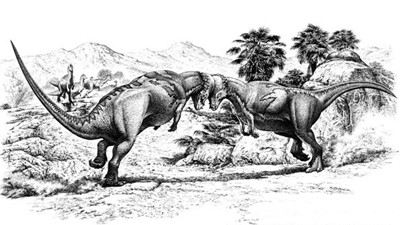科學(xué)技術(shù)
Dinosaur behaviour
恐龍行為
Headbangers
瘋狂撞頭的家伙
Evidence of duelling dinosaurs
戰(zhàn)斗性恐龍的證據(jù)
WORKING out how an extinct animal behaved when it was alive is tricky.
對(duì)于滅絕的生物來說,要研究出它們存活時(shí)的行為是很棘手,
But it is not always impossible,
不過也不是完全不可能。
 as Joseph Peterson and Collin Dischler of the University of Wisconsin explained on October 17th to the Society of Vertebrate Palaeontology meeting held in Raleigh, North Carolina.
as Joseph Peterson and Collin Dischler of the University of Wisconsin explained on October 17th to the Society of Vertebrate Palaeontology meeting held in Raleigh, North Carolina.
10月17日,在北卡羅萊納州羅利市舉行的古脊椎動(dòng)物學(xué)會(huì)議上,美國威斯康星大學(xué)的約瑟夫·彼得森和柯林·狄斯勒就對(duì)腫頭龍的習(xí)性做出了一些解釋。
Pachycephalosaurs lived 65m years ago.
腫頭龍生活在6500萬年前。
As their name suggests, they had large, bony, domed heads.
正如其名稱所說,它們有巨大的、高隆的頭骨。
For years, it was assumed they used these to bash one another in the way that rams do now.
多年來,人們一直認(rèn)為腫頭龍用頭攻擊同類,就像現(xiàn)在的公羊一樣。
Recently, though, a second suggestion has surfaced—that rather than for fighting, the domes were for show; the dinosaur equivalent of a peacock's tail.
不過最近有人提出另外一個(gè)假設(shè):它們的大腦袋不是為了戰(zhàn)斗,而是出于展示的目的—作用相當(dāng)于孔雀的尾巴。
Dr Peterson and Dr Dischler put these two theories into a head-to-head competition.
彼得森和狄斯勒博士讓這兩種理論來了個(gè)頭對(duì)頭的正面對(duì)抗。
To do so, they studied 102 pachycephalosaur skulls, of various species.
為此,他們研究了102只不同品種腫頭龍的頭骨。
They found that 23 of these skulls had pits in them, and that these pits were similar both to each other and to those found in the skulls of living animals that bash each other with their heads.
他們發(fā)現(xiàn)其中23只頭骨上有凹坑。這些凹坑彼此類似。而且現(xiàn)存的用頭部撞擊同類的動(dòng)物中,頭骨上的凹坑也與之類似。
That supported the head-butting theory. The clincher, though, came when they created computerised models of pachycephalosaur skulls and mapped the damage from each of their pitted specimens on to these virtual skulls.
這支持了頭部沖撞理論。不過決定性的證據(jù)來自于他們用計(jì)算機(jī)模擬的腫頭龍頭骨。他們將每個(gè)有坑樣本的損傷部位標(biāo)注在虛擬的頭骨上。
When they did this, they found that the pits were clustered—exactly as might be expected if they were the result of animals deliberately aiming at each other.
這樣操作后,他們發(fā)現(xiàn)凹坑聚集分布,正如人們假設(shè)的那樣:是腫頭龍故意用頭部攻擊彼此的結(jié)果。
Intriguingly, they found two patterns of clustering.
有意思的是,他們發(fā)現(xiàn)凹坑有兩種聚集圖案。
Those pachycephalosaurs with highly domed heads had pits on both the fronts and the backs of their skulls.
那些不太隆起的頭骨僅在前方有凹坑,而非常高隆的則前后都有。
Those whose domes were lower had them only on the fronts.
這證明了兩種腫頭龍攻擊時(shí)的不同。
This suggests the two sorts of animal fought in different ways. Low-domes, it seems, simply charged at each other. High-domes did that too.
相對(duì)低隆的一種似乎僅向?qū)Ψ接^沖撞。
But they also engaged in head-to-head wrestling of a sort that allowed them to get behind their opponents'skulls and do damage from the rear, in the way that modern bison do.
非常高隆的腫頭龍除此之外還會(huì)采取頭對(duì)頭式摔跤法:能夠碰到對(duì)方頭骨的背部,從后面對(duì)彼此造成損傷,好比如今的野牛。
None of which proves that pachycephalosaurs did not strut their stuff with their domes as well, just as a stag will often show off its antlers before engaging in combat, in order to give a less well-endowed rival the opportunity to withdraw.
然而,兩種圖案都沒有否定腫頭龍自豪地邁步時(shí)也在炫耀他們的大腦袋。成年雄鹿就經(jīng)常在戰(zhàn)斗之前展示它的鹿角,為了使天生劣勢的對(duì)手借機(jī)撤退。
But it does demonstrate that the domes were serious weapons, not mere fripperies of fashion.
不過這確實(shí)證明了高隆的頭骨是很厲害的武器,而不僅僅是時(shí)髦的矯飾品。
 as Joseph Peterson and Collin Dischler of the University of Wisconsin explained on October 17th to the Society of Vertebrate Palaeontology meeting held in Raleigh, North Carolina.
as Joseph Peterson and Collin Dischler of the University of Wisconsin explained on October 17th to the Society of Vertebrate Palaeontology meeting held in Raleigh, North Carolina.
 as Joseph Peterson and Collin Dischler of the University of Wisconsin explained on October 17th to the Society of Vertebrate Palaeontology meeting held in Raleigh, North Carolina.
as Joseph Peterson and Collin Dischler of the University of Wisconsin explained on October 17th to the Society of Vertebrate Palaeontology meeting held in Raleigh, North Carolina.